Most males are perfect by the thirtieth day, but females seldom before the forty-second or forty-fifth day, because the heat of the womb is greater in producing the male than the female. And, for the same reason, a woman going with a male child quickens in three months, but going with a female, rarely under four, at which time its hair and nails come forth, and the child begins to stir, kick and move in the womb, and then the woman is troubled with a loathing for meat and a greedy longing for things contrary to nutriment, as coals, rubbish, chalk, etc., which desire often occasions abortion and miscarriage. Some women have been so extravagant as to long for hob nails, leather, horse-flesh, man’s flesh, and other unnatural as well as unwholesome food, for want of which thing they have either miscarried or the child has continued dead in the womb for many days, to the imminent hazard of their lives. But I shall now proceed to show by what means the child is maintained in the womb, and what posture it there remains in.
The learned Hippocrates affirms that the child, as he is placed in the womb, has his hands on his knees, and his head bent to his feet, so that he lies round together, his hands upon his knees and his face between them, so that each eye touches each thumb, and his nose betwixt his knees. And of the same opinion in this matter was Bartholinus. Columbus is of opinion that the figure of the child in the womb is round, the right arm bowed, the fingers under the ear, and about the neck, the head bowed so that the chin touches the breast, the left arm bowed above both breast and face and propped up by the bending of the right elbow; the legs are lifted upwards, the right so much that the thigh touches the belly, the knee the navel, the heel touches the left buttock, and the foot is turned back and covers the secrets; the left thigh touches the belly, and the leg lifted up to the breast.
* * * * *
CHAPTER III
The reason why children
are like their parents; and that the
Mother’s imagination
contributes thereto; and whether the man or
the woman is the cause
of the male or female child.




